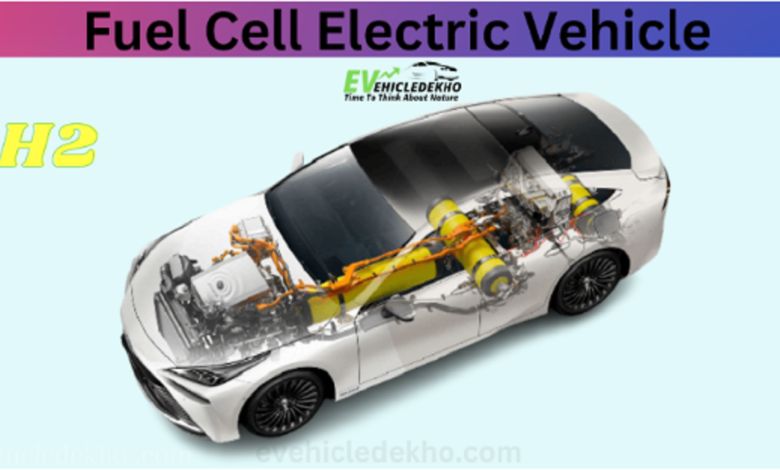Fuel Cell Electric Vehicle

Fuel Cell Electric Vehicles (FCEVs) are a type of electric vehicle that uses a fuel cell stack to generate electricity, which powers an electric motor. The fuel cell stack creates an electrochemical reaction between hydrogen and oxygen to produce electricity, with the only by-products being water and heat. FCEVs offer several advantages over traditional gasoline vehicles and battery electric vehicles (BEVs). One of the main advantages is their ability to refuel quickly, similar to a traditional gasoline vehicle, while also producing zero emissions. They also have a longer driving range compared to BEVs, which need to be recharged. However, FCEVs currently face several challenges, such as limited availability and a limited number of hydrogen refuelling stations. They are also more expensive to purchase than traditional gasoline vehicles and BEVs. Despite these challenges, the future of FCEVs looks promising as governments around the world invest in this technology and the infrastructure to support it. The growth of the hydrogen economy and increasing demand for sustainable modes of transportation will likely drive the continued growth of the FCEV market.
Fuel Cell Electric Vehicle
Fuel Cell Electric Vehicles (FCEVs) are becoming increasingly popular as a sustainable mode of transportation. Here are a few key points about these vehicles:
- How it Works: FCEVs use a fuel cell stack to generate electricity through an electrochemical reaction between hydrogen and oxygen, producing only water and heat as by-products. The electricity generated is used to power an electric motor, which drives the vehicle.
- Hydrogen Fuel: Unlike traditional electric vehicles, which use batteries that need to be recharged, FCEVs rely on hydrogen fuel, which can be refilled in a matter of minutes, just like refuelling a traditional gasoline vehicle.
- Environmentally Friendly: FCEVs produce zero emissions, making them an environmentally friendly alternative to traditional gasoline vehicles. The only by-product of the reaction in the fuel cell is water, making FCEVs a clean energy source for transportation.
- Increased Driving Range: With a full tank of hydrogen, FCEVs can drive hundreds of miles without the need for refuelling, offering drivers increased driving range compared to traditional electric vehicles.
- Cost: While FCEVs are currently more expensive to purchase than traditional gasoline vehicles, they offer a number of cost-saving benefits in the long run, such as lower fuel costs and lower maintenance costs.
In conclusion, FCEVs offer a sustainable and environmentally friendly mode of transportation that has the potential to change the way we think about powering our vehicles. As the technology continues to advance and the infrastructure to support it grows, we can expect to see even greater adoption of FCEVs in the future. Read also Yamaha V Star 650 Custom
Fuel Cell Electric Vehicle Work
Fuel cell electric vehicles (FCEVs) work by using a fuel cell stack to generate electricity through an electrochemical reaction between hydrogen and oxygen. The electricity generated powers an electric motor, which drives the vehicle. The fuel cell stack consists of a number of individual fuel cells that are stacked together, creating a more powerful system. In the fuel cell, hydrogen is fed into the anode and oxygen is fed into the cathode. The hydrogen atoms are stripped of their electrons, creating positively charged ions. These ions flow through a polymer electrolyte membrane to the cathode, where they react with oxygen and the electrons to produce water and heat. The flow of electrons in the circuit creates an electric current, which is used to power the electric motor. The only by-products of the reaction in the fuel cell are water and heat, making FCEVs a clean energy source for transportation. The hydrogen used to power FCEVs can be produced from various sources, including natural gas, bio-gas, or through the process of electrolysis using renewable energy sources like wind and solar. In comparison to traditional internal combustion engines, FCEVs are much more efficient and produce zero emissions, making them an environmentally friendly alternative to traditional gasoline vehicles. For more Updates Follow US Wordle
Future of Fuel Cell Electric Vehicle
The future of Fuel Cell Electric Vehicles (FCEVs) is promising as they offer a sustainable and environmentally friendly mode of transportation. Here are some key factors that will impact the future of FCEVs: Increased Production: As demand for FCEVs continues to grow, the production of these vehicles is expected to increase, making them more widely available and affordable for consumers.
- Expansion of Hydrogen Refuelling Infrastructure: The growth of the FCEV market is directly linked to the expansion of the hydrogen refuelling infrastructure. As more hydrogen refuelling stations are built, FCEVs will become more convenient to own and operate, further boosting their popularity.
- Government Support: Governments around the world are investing in FCEVs and the infrastructure to support them, recognizing the potential they have to reduce greenhouse gas emissions and improve air quality. Government incentives and subsidies can help reduce the upfront cost of FCEVs and make them more accessible to consumers.
- Advancements in Technology: As the technology continues to evolve, FCEVs are expected to become more efficient, offer increased driving range, and have improved performance.
- Competition with Battery Electric Vehicles (BEVs): FCEVs will compete with Battery Electric Vehicles (BEVs) for market share. While BEVs have a more established infrastructure and are currently more widely available, the longer driving range and faster refuelling time of FCEVs may make them more appealing to some consumers.
In conclusion, the future of FCEVs is bright as the technology continues to advance and the infrastructure to support them expands. The continued growth of the FCEV market will be driven by increasing demand, government support, and advancements in technology.



